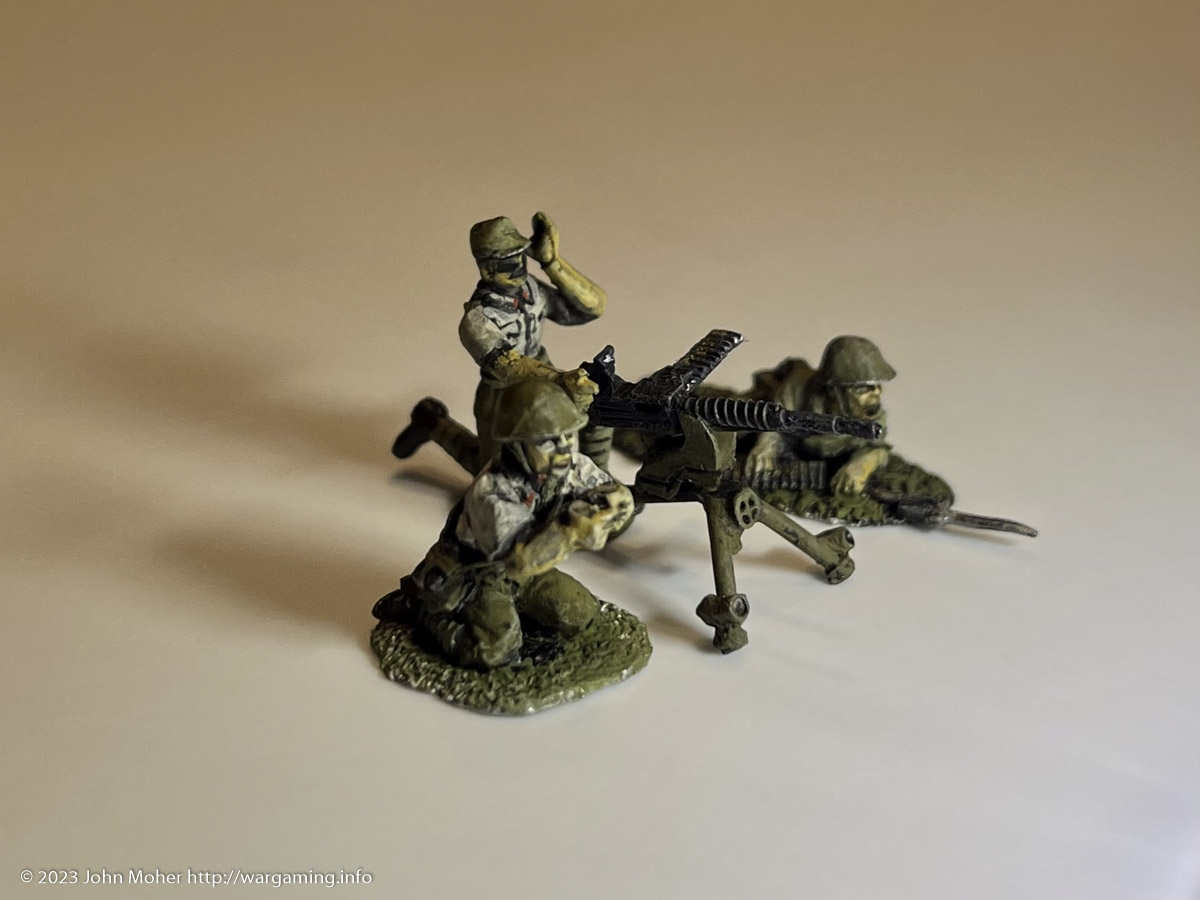I’ve thought about the Japanese HMG representation in Crossfire for many years. Specifically why did Arty & Rob decide to make them fire with only 3D? Here’s my latest thoughts and a proposed revision…
In Crossfire it states that all Japanese HMGs (in addition to costing the same as HMGs of other nations):
count as Crew-Served weapons except that they use only 3 firing Dice; they do not apply the -2 Crew modifier in Close Combat and may initiate Close Combat
Crossfire Rulebook, Page 24
Is the reduction in firepower there simply to balance out the improved close combat stats and the ability to initiate charges/close combat; or is it due to the myths around the Type 92, the infamous Woodpecker, and the impression that it wasn’t that good because it used the Hotchkiss style clips to the feed the gun and had a perceived low rate of fire? The latter points seem most likely, as up until the late 1990’s a lot of myths from World War II were regularly included in historical works and the authors would have been influenced by these given Crossfire was published in 1996. Possible also, if the latter is true, were the extra abilities for close combat then also added principally to offset the drop to only 3D for firing (given the stand cost was the same as any other nations 4D HMG)?

The fact is there appears no logical reason for firepower reduction – the claims that the Woodpecker was an inferior machine gun are largely myths. It was a good quality, solid, well built machine gun and was also capable of (and regularly used for) long range indirect fire (exactly as the British & Commonwealth Vickers guns were). It was extremely reliable and robust, didn’t jam easily, was a very stable firing platform and used a good cartridge (7.7mm). Like the Nambu (Type 96 & 99) LMGs it also featured a telescopic sight for longer range fires.
While its cyclical rate of fire was lower than other comparable tripod machine guns (at 450 rpm) this is largely irrelevant from a wargaming perspective (just as, conversely, the high German MG34 and MG42 cyclical rates are also, as these guns never were fired continuously at this rate, nor could they have been); 450 rpm is more than adequate for a typical HMG team consuming ammunition in real life battlefield conditions. Only around 120-200 rounds per minute would be fired in typical situations by any MG team in any form of sustained firing. The Type 92’s clips would put you at the lower end of that range most likely, but not enough to render it sufficiently less effective.
There is also not really a case for not treating them as crew served weapons in close combat. After all while the Japanese were often unwilling to surrender and would fight to the death a Japanese HMG team is unlikely to have any more weapons or extra abilities in close combat versus an Allied one. i.e. they won’t all have bayonets, sub-machine guns, and copious grenades. I think the ability for them to initiate close combat feels right for Japanese fanaticism in combat, but it doesn’t mean they were better armed, harder to kill, and fought better in close combat (remember this isn’t always about purely ‘hand to hand’ fighting, but also close range grenading, gun fire, etc).
So my argument is Japanese HMGs in Crossfire should most definitely get 4D the same as all other nation’s HMGs. They should not be penalised for firepower, and also don’t warrant the bonus of not being classed ‘crew served’ in close combat. So this is how I now think Japanese HMGs should be treated:
- Fire with 4 Dice
- Can initiate Close Combat (charge enemy in LOS)
- Still always count as -2 Crew Served Stand in Close Combat
- Cost the same as current (if you use the points system)

More Info & Selected References
- Type 92 heavy machine gun (wikipedia)
- Forgotten Weapons: Type 92 Japanese HMG at James D Julia
- World War Two Fact Files: Machine Guns by Peter Chamberlain & Terry Gander
- The Encyclopedia of Infantry Weapons of World War II by Ian V. Hogg
- Japanese Army of World War II (Osprey Men-At-Arms No.20) by Philip Warner
- Japanese Army in World War II: Conquest of the Pacific 1941-42 (Osprey Battle Orders No.9) by Gordon Rottman
- Japanese Army in World War II: The South Pacific and New Guinea 1942-43 (Osprey Battle Order No.14) by Gordon Rottman
- Various assorted Historical Works & Accounts of Battles & Actions in the Pacific, China & Far East involving the Japanese in WW2.
More Wargaming.info Crossfire Japanese
- Modelling Japanese in Crossfire (my thoughts on Japanese in Crossfire)
- Banzai – The Japanese are Coming! (preliminary pics of my Crossfire Japanese as I completed phase 1 of basing them)

Thanks John. Well reasoned arguments.
Totally agree on 4d6 like other HMG.